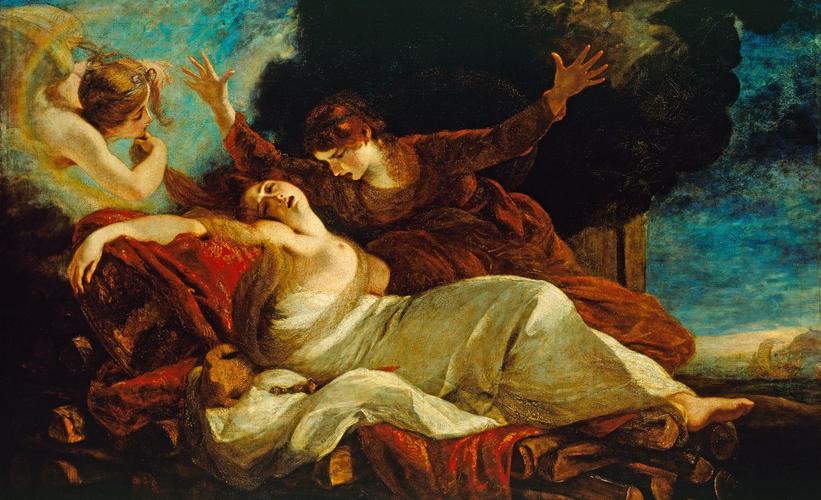The Death of Dido c.1775-81
Oil on canvas | 147.5 x 239.2 cm (support, canvas/panel/stretcher external) | RCIN 404696
-
When George III was asked by Lord Eglinton to sit for the most fashionable portrait painter of the day, Joshua Reynolds, he replied: ‘Mr Ramsay is my painter, my Lord.’ Reynolds tried to gain royal notice with two speculative ventures – a portrait of George III as Prince of Wales (OM 1011, 401034) and an oil sketch for a depiction of his marriage to Queen Charlotte (OM 1012, 404353) – both of which remained on his hands. Reynolds was knighted by George III, made first president of the Royal Academy and Principal Painter to the King upon Ramsay’s death in 1784, but never asked to paint anything. That the Royal Collection has a fine group of Reynolds is entirely thanks to George IV, who commissioned portraits at the end of the artist’s life and acquired many examples of his earlier work. This is one of a group of highly personal works (OM 1008, 400699, OM 1011, 401034, OM 1029-31, 404695-6 and 405712) obtained by him at various times from Reynolds’s niece and heiress, Mary Palmer, Marchioness of Thomond (1750-1820). This painting was exhibited at the Royal Academy in 1781 and is an early and important example of Reynolds trying to practise what he so often preached by painting a full-sized heroic subject picture. The postures of abandonment and extravagant grief are familiar from the Italian baroque. Reynolds has added an unusual figure: Iris, goddess of the rainbow, sent by Juno to cut off a lock of Dido’s hair and thereby release her spirit. Perhaps he is also trying to suggest a transition from storm to rainbow-calm in the sky to complement the human action. Dido lies on her funeral pyre attended by her sister, Anna; she lies upon the dagger which has just pierced her and a bronze statuette, possible a household god. To the far right the fleet of Aeneas can be seen putting to sea. The details can be better appreciated in Bone's enamel copy (404248).
Provenance
Acquired by George IV in 1821; added to the Carlton House inventory dated 1816 (no 581) and 1819 (no 576); in the Picture Gallery at Buckingham Palace in 1841 (no 89)
-
Creator(s)
Acquirer(s)
-
Medium and techniques
Oil on canvas
Measurements
147.5 x 239.2 cm (support, canvas/panel/stretcher external)
Category
Object type(s)









